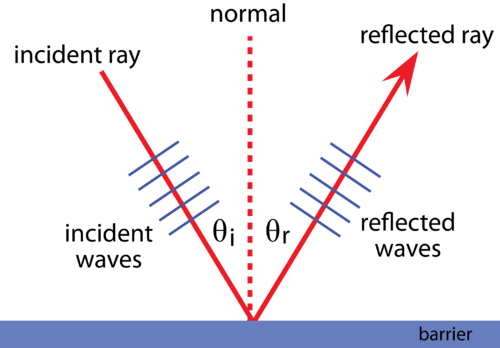The designers of this sign used the fact that light can reflect off of many surfaces, including water, to make the sign legible. It takes a bit of thought, but words can be written in such a way that their reflection is legible, even though the words themselves are not.
Reflection of Light
The Law of Reflection
When a light ray strikes a reflecting surface, the angle of incidence (measured from the normal line) is equal to the angle of reflection (also measured from the normal line). This is called the Law of Reflection.
If the reflecting surface is a very smooth surface, the reflection will be a regular reflection, in which the light rays maintain their position relative to each other and objects will be visible and identifiable in the reflected image. If the reflecting surface is rough, the reflection will be a diffuse reflection, and objects will not be visible or identifiable in the reflection. When you are considering the size of things on the scale of wavelengths of light, even surfaces that appear smooth may be very rough in terms of light waves, and most surfaces produce diffuse reflection.
Left and Right Reversal in a Plane Mirror
The images that appear in a plane (flat) mirror are reversed in some ways and not reversed in other ways. In the image below, the man's right hand is labeled. The same hand in the mirror image, however, looks like a left hand. While the left and right of the image are reversed, the top and bottom of the image are not.
In the simulation below, the young man is getting ready for the prom. He needs to stand at a particular distance and have the mirror be a particular length to be able to view his entire body. Rays of light are emerging from various light sources in the room and bouncing off him into the mirror. Play around with rays from different locations, try different mirror lengths, and see what you can discover about the reflection of light in a mirror.
Summary
- The law of reflection states that, when a light ray strikes a reflecting surface, the angle of incidence (measured from the normal line) is equal to the angle of reflection (also measured from the normal line).
- If the reflecting surface is a very smooth surface, the reflection will be regular, in which the light rays maintain their position relative to each other.
- If the reflecting surface is rough, the reflection will be diffuse and objects will be distorted in the reflection.
- Images in a plane mirror are reversed left and right but not reversed top and bottom.
Review
- How does regular reflection differ from diffuse reflection?
- If a light ray strikes a mirrored surface at an angle of 25° to the surface, what is the angle of incidence?
- For problem #2, what will be the angle of reflection?
- A dry cement road is a diffuse reflector. When it rains, the water fills in all the little holes and cracks in the cement road and it becomes a smooth regular reflector. At night, when you are depending on the light from your headlights to show you the lines on the road, a wet road becomes much darker and it is more difficult to see the lines. Explain why this occurs.
When a light ray passes at an angle through the boundary between optically different media, the light does not travel in a straight line. The pencil in the glass of liquid shown above is a normal straight pencil. The light that travels from the pencil through the liquid, through the glass, and into the air is bent differently than light from the portion of the pencil that is not in the liquid. Your eye assumes the light from both portions of the pencil moved in a straight line, but the two portions of the pencil do not appear to be lined up. Your eye thinks the pencil is broken.
Refraction of Light
The speed of light is different in different media. If the speed of light is slower in a particular medium, that medium is said to be more optically dense. When a wave front enters a new medium at an angle, it will change directions. If the light is entering a more optically dense medium, the light bends toward the normal line. If the light is entering a less optically dense medium, the light will bend away from the normal line. Remember that the normal line is the line perpendicular to the medium interface.
In the sketch below, light wave fronts are moving upward from the bottom of the page and encounter a boundary into a more optically dense medium. The light waves bend toward the normal line. Because the right end of the wave fronts enter the new medium first, they slow down first. When the right side of the wave front is moving more slowly that the left side, the wave front will change directions.
When light is traveling from air into another medium, Snell’s Law states the relationship between the angle of incidence and angle of refraction is
where
The index of refraction is also related to the relative speeds of light in a vacuum and in the medium.
When a ray of light is traveling from medium into another medium, Snell’s Law can be written as
Example 1A ray of light traveling through air is incident upon a slab of Flint glass at an angle of The angle of refraction Example 2What is the speed of light in a diamond? In the Least Time simulation below, you can adjust the sliders so that light travels from air to a denser material like glass or diamond. Then, drag the incident ray and refracted rays to the correct angles according to Snell’s Law. When you have found the path of least time - a red light ray will shoot out across the both materials! Very exciting!
Effects of RefractionBending the Sun’s RaysBecause air is slightly more optically dense than a vacuum, when sunlight passes from the vacuum of space into our atmosphere, it bends slightly towards the normal. When the sun is below the horizon and thus not visible on a direct line, the light path will bend slightly and thus make the sun visible by refraction. Observers can see the sun before it actually comes up over the horizon, or after it sets. MiragesIn the Figure below, the sun shines on the road, heating the air just above the road. The difference in density between the hot air over the road and the surrounding air causes the hot air to refract light that passes through it. When you look at the road, you see a mirage. What appears to be water on the road is actually light coming from the sky that has been refracted as it passes through the hot air above the road. This phenomenon is common on hot roads and in the desert. Summary
Review
|



















0 Comments